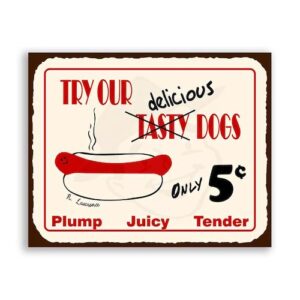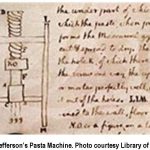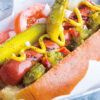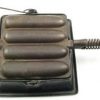Hot Dogs, Another Iconic American Food

The popularity of hot dogs in this country is second only to that of the hamburger. And it just so happens I love them both, with perhaps the burger edging out hot dogs by just a hair. One of the main reasons for that is probably because while growing up we didn’t eat hot dogs at our house. My father was strictly a hamburger man who treated the family to a night at the local burger drive-in every six or eight weeks. The fact is, my first exposure to hot dogs came as a young teen at a Sunday school class cookout. And it was love at first bite!
Growing up in North Texas, I don’t recall ever seeing a hot dog stand until in my mid-twenties when Wienerschnitzel came to town. About that same time, a local startup chain of parking lot, kiosk-style hot dog stands called The Dog House (not to be confused with today’s Dog Haus chain) opened. So for several years I was able to choose between a hot dog or hamburger as my frame of mind would dictate. But alas, those restaurants have all but disappeared, leaving only seven fast-food hamburger joints and four gas station/convenience stores near my neighborhood. And their hot dog offerings are second-rate at best. So instead of taking the ten-minute drive to one of them, I opt to make my hot dogs at home, where I can grill them to perfection and enjoy them with whatever toppings I’m in the mood for.
Now, I have to ask how many of you hot dog lovers out there ever wondered about the origin of this American icon? Or how it got its name? Hopefully this article will answer some of those questions, as well as provide you with some interesting hot dog trivia.
Technically a sandwich (not according to the National Hot Dog and Sausage Council, or NHDSC), the hot dog consists of a boiled, steamed, or grilled sausage, known as a wiener or frankfurter, tucked into a specially designed bun. Hot dogs are usually eaten dressed with condiments or toppings that can vary depending on your country, state, or locale. These generally include mustard, relish, diced onion, and/or cheese. Other popular toppings include sauerkraut, chili, bacon, coleslaw, jalapeños, tomatoes, and yes, even mayonnaise and ketchup. The hot dog bun is soft, elongated to fit the shape of the frank/wiener, side split or top split, plain or seeded.
 As with most ancient food stuffs, there are claims and counterclaims regarding the invention of the hot dog. The city of Frankfurt, Germany claims itself the birthplace of the hot dog sausage some five years before Christopher Columbus crossed the Atlantic to discover the New World. Their claim is backed by the name “frankfurter.” In fact, to add weight to their claim, the city threw a huge celebration in 1987 to honor the 500-year anniversary of the hot dogs birth.
As with most ancient food stuffs, there are claims and counterclaims regarding the invention of the hot dog. The city of Frankfurt, Germany claims itself the birthplace of the hot dog sausage some five years before Christopher Columbus crossed the Atlantic to discover the New World. Their claim is backed by the name “frankfurter.” In fact, to add weight to their claim, the city threw a huge celebration in 1987 to honor the 500-year anniversary of the hot dogs birth.
Then there’s the city of Vienna, Austria with their clam that in the late 1800s two of their residents, Emil Reichel and Sam Ladany, were the inventors, naming it “wienerwurst” after the German word for Vienna, “Wien.” The legend goes on to say that the couple brought their invention to the 1893 World’s Fair in Chicago to introduce Fairgoers their invention. After the Fair closed Reichel and Ladany founded Vienna Beef, a Chicago hot dog manufacturer who remains in the heart of that city to this day.
And if that were not enough, enter Johann Georghehner, a butcher from Coburg, Germany who in the late 1600s supposedly was the hot dogs creator. It is said that he traveled to Frankfurt to introduce his invention to the world. Let’s see, that was only a hundred years after the city of Frankfurt had claimed itself the birthplace. Strange?
"My real love was Chicago street food, specifically Chicago-style hot dogs, like Portillo's serves."
—Jimmy John Liautaud, Owner of Jimmy John's
While highly unlikely that we will ever uncover its exact origin, we do know that the sausage known as wieners and frankfurters came to America in the late 19th century by way of German immigrants.
 It is believed that the first hot dogs (referred to then as dachshund sausages) sold in America were sold in New York City’s Bowery during the 1860s by an unknown German immigrant street vendor, along with milk rolls and sauerkraut.
It is believed that the first hot dogs (referred to then as dachshund sausages) sold in America were sold in New York City’s Bowery during the 1860s by an unknown German immigrant street vendor, along with milk rolls and sauerkraut.
Then around 1867 another German immigrant and butcher named Charles Feltman began pushing a pie cart through the sands of Coney Island, selling franks in a milk roll. During his first year in business, Feltman sold more than 3,600 of his sausages on a bun at 10-cents each. Four years later he leased a small plot of land in Coney Island and built the first hot dog stand. Feltman enjoyed enormous success, allowing him to build an empire that consisted of nine restaurants, a carousel, roller coaster, hotel, beer garden and more. By the 1920s,  Feltman’s Ocean Pavilion was selling as many as 40,000 hot dogs he called “red hots” a day.
Feltman’s Ocean Pavilion was selling as many as 40,000 hot dogs he called “red hots” a day.
The year 1893 was an important date in hot dog history. Not only was that the year of Chicago’s Columbian Exposition which brought thousands of visitors, many of which consumed large quantities of the dachshund sausages on milk rolls, but also the year these sausages became standard baseball park fare, a tradition believed to have started with German immigrant Chris Von de Ahe, a bar owner who also owned the St. Louis Browns major league baseball team.
 Enter Nathan Handwerker, a Jewish immigrant from Poland. As the story goes, Handwerker was employed by Feltman’s Coney Island hot dog stand in 1915 as a bun slicer for $11 a week. During the year Handwerker worked for Feltman he sacrificed and saved his money until he finally had accumulated $300, enough to open a competing hot dog stand on the corner of Surf and Stillwell Avenues in Coney Island, along with his wife Ida. It is said that Ida Handwerker developed the hot dog recipe and her grandmother created the secret spice mix used in it. An astute businessman, Handwerker sold his dogs for 5 cents apiece, half the price of Feltman’s hot dogs. And while, despite some rumors, Nathan did not force his old employer out of business, he was a force to reckon with. Nathan’s Famous was born and by the 1920s became known nationwide.
Enter Nathan Handwerker, a Jewish immigrant from Poland. As the story goes, Handwerker was employed by Feltman’s Coney Island hot dog stand in 1915 as a bun slicer for $11 a week. During the year Handwerker worked for Feltman he sacrificed and saved his money until he finally had accumulated $300, enough to open a competing hot dog stand on the corner of Surf and Stillwell Avenues in Coney Island, along with his wife Ida. It is said that Ida Handwerker developed the hot dog recipe and her grandmother created the secret spice mix used in it. An astute businessman, Handwerker sold his dogs for 5 cents apiece, half the price of Feltman’s hot dogs. And while, despite some rumors, Nathan did not force his old employer out of business, he was a force to reckon with. Nathan’s Famous was born and by the 1920s became known nationwide.
Over the next decade the hot dog's popularity grew to become a living piece of American culture, appearing in backyard cookouts, July 4th, and Memorial Day celebrations. In 1939 first lady Eleanor Roosevelt even served hot dogs at a picnic in Hyde Park honoring the first visit to America by England’s King George VI and Queen Elizabeth (Rumor is that the King enjoyed his dog so much he had a second). That was the same year that Paul and Betty Pink gave the West Coast its own iconic hot dog stand, Pink’s in Los Angeles.
“Nobody, I mean nobody, puts ketchup on a hot dog."
—Clint Eastwood as Dirty Harry in the movie “Sudden Impact”
But wait!! Up until now we’ve overlooked a very important part of this icon’s history, the bun! Without the bun there is no hot dog, only franks and wieners. There is a myth that goes as follows: Around 1880, Antoine Feuchtwanger, a German immigrant and sausage peddler on the streets of St. Louis, Missouri, supplied white gloves to his customers to prevent them from getting grease on themselves. But many customers would walk off with his gloves, thereby causing him to lose money. So Feuchtwanger’s wife suggested having her brother, a baker, make a long, soft roll in which to sell his dachshund sausages and so the bun was born. Unfortunately this is only a myth and totally not true. The hot dog bun can actually be traced back as far as the mid-1800s.
A much more credible story centers around Austrian baker, Ignatz Frischman, who arrived in Coney Island, New York sometime before 1850. He keenly noted that the crowds there had a real passion for frankfurter/wiener sandwiches, which until then was served between slices of bread. So when Frischman opened his bakery, he made an oblong roll which, according to the Brooklyn Daily Times, he sold to the “frankfurter men.” The popularity of his rolls continued to grow until it was “the only way frankfurters could be sold,” wrote the Iola Daily Record.
 Our next question centers around how the hot dog got its name. Again, there are several myths out there concerning the subject. One such myth concerns the famous sports cartoonist, T. A. “TAD” Dorgan, who upon hearing hawkers at a 1901 Giants baseball game yelling “Get your dachshund sausages while they’re hot,” drew a cartoon of a sausage nestled in a bun. But since he couldn’t spell dachshund, he captioned his work simply “Hot dog!” Problem is, Dorgan wasn’t in New York in 1901 and there is no record of this cartoon ever existing. Seems this story was fabricated and circulated by a concessionaire named Harry Stevens in order to grab a piece of the credit for the hot dogs name.
Our next question centers around how the hot dog got its name. Again, there are several myths out there concerning the subject. One such myth concerns the famous sports cartoonist, T. A. “TAD” Dorgan, who upon hearing hawkers at a 1901 Giants baseball game yelling “Get your dachshund sausages while they’re hot,” drew a cartoon of a sausage nestled in a bun. But since he couldn’t spell dachshund, he captioned his work simply “Hot dog!” Problem is, Dorgan wasn’t in New York in 1901 and there is no record of this cartoon ever existing. Seems this story was fabricated and circulated by a concessionaire named Harry Stevens in order to grab a piece of the credit for the hot dogs name.
And while there are several other myths as well, let us concentrate on the real story. A story brought about by rumor and speculation dating as far back as the Middle Ages on what is used to make sausages, some of which enjoyed a certain amount of truth. Meat packers in those days were known to add sawdust, formaldehyde, and other fillers in their sausages. A popular 19th century conjecture was that frankfurters contained dog meat. Because of this, college students began to jokingly refer to the pushcarts gathered near their dorms as “dog wagons.” And it was out of this crude college humor that the term “hot dog” was born. Today, the term hot dog can mean the combination of bun and frankfurter (or wiener, if that is your reference) or it can refer only to the frank itself.
One last word on the subject. Today’s frankfurters/wieners not only taste good but nutritious, and safe as well. Meats used to make most hot dogs pretty much resemble the meats we buy from our grocery case. If any by-products are used, the Department of Agriculture requires the manufacturer to not only state on the package that the product “contains variety meats” or “meat byproducts,” but they must state exactly what they are.
Today’s average, standard size all-beef hot dog today contains about 186 calories (a white or wheat bun will another 100 calories), 17 grams of total fat, 2 grams of carbohydrates, and 7 grams of protein. Just one dog provides 30% of the DV of vitamin B12 and 10% of minerals like phosphorus, selenium, and zinc. And like all meats and poultry products, hot dogs are USDA inspected to ensure they are safe and properly labeled.
Now that we’ve covered much about the hot dogs origin, the time has come to ask one of the most lingering and frustrating questions on the subject. Why does a package of franks and a package of buns never match?
Well, it seems that back in 1940 when manufacturers began packaging hot dogs for supermarkets, they chose 10 as the magic number because it is all about weight. The average hot dog weighs 1.6 ounces, and it takes 10 of those franks to make a pound, the standard by which all meat is sold. Today hot dogs are also available in packs of six, seven, or eight but the individual franks in those packs weigh more.
 Buns on the other hand are sold in packages of eight because the automated lines they are baked on utilize clusters of four in pans designed to hold eight buns. And while pans are available for baking 10 or 12 at a time, the eight to a pan remains the most popular size of the industry. And since these buns are used for a variety of sausage types and sizes, as well as for other purposes it will likely remain unchanged for the foreseeable future. So while this knowledge does nothing to resolve the dilemma, it does explain why.
Buns on the other hand are sold in packages of eight because the automated lines they are baked on utilize clusters of four in pans designed to hold eight buns. And while pans are available for baking 10 or 12 at a time, the eight to a pan remains the most popular size of the industry. And since these buns are used for a variety of sausage types and sizes, as well as for other purposes it will likely remain unchanged for the foreseeable future. So while this knowledge does nothing to resolve the dilemma, it does explain why.
I hope you have enjoyed learning a little about another of America’s iconic foods, and will subscribe to our blog so you never miss the latest installment. And if you want to know about another of America’s lost or popular foods, just let us know in the comments section below.








